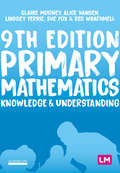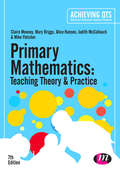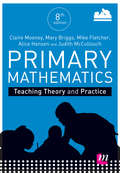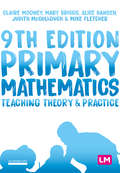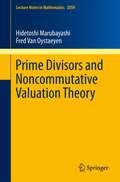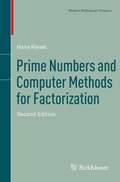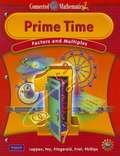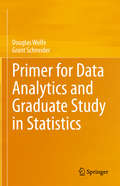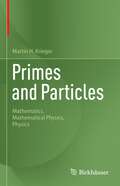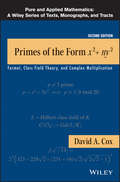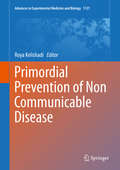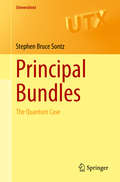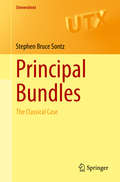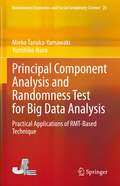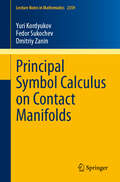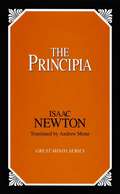- Table View
- List View
Primary Mathematics: Knowledge and Understanding
by Sue Fox Claire Mooney Alice Hansen Lindsey Ferrie Reg WrathmellThe 6th edition of this popular core text is the essential subject knowledge book for primary mathematics. Helping trainees to establish and consolidate a secure subject knowledge and understanding of primary mathematics, it promotes the development of confident, creative and effective teachers. This 6th edition is linked to the 2012 Teachers' Standards. Providing full coverage of the required subject knowledge for primary mathematics, this is a core text for primary trainees working towards QTS. Self assessment questions enable readers to understand their own level of knowledge and an M level extension feature in all chapters suggests avenues for further study at Masters level. Research summaries include the latest works in primary mathematics and throughout interactive tasks engage the reader with the text, helping them to link theory and practice. Trainees will find it helpful to use this book alongside Primary Mathematics Teaching Theory and Practice. About the Achieving QTS series All the books in this successful series support trainees through their initial teacher training and guide them in the acquistion of their subject knowledge, understanding and classroom practice. All new titles within the series link to the 2012 Teachers' Standards and take in to account recent changes in Initial Teacher Training.
Primary Mathematics: Knowledge and Understanding (Achieving QTS Series)
by Sue Fox Claire Mooney Alice Hansen Reg Wrathmell Lindsey DavidsonAll the subject knowledge you need to teach primary Mathematics. Secure subject knowledge and understanding is the foundation of confident, creative and effective teaching. To help you master this, this comprehensive text includes subject knowledge from each part of the primary Mathematics curriculum and comes with a wide range of resources so you can test your knowledge as you progress through the course. an online Mathematics subject knowledge audit with the ability to share results with lecturers new end of chapter self-assessment questions Interactive tasks a Maths subject knowledge checklist useful weblinks for primary Maths teaching Recommended further reading The 9th edition has been updated in line with new guidance and framework updates, inluding the new EYFS, as well as links to new research.
Primary Mathematics: Knowledge and Understanding (Achieving QTS Series)
by Sue Fox Claire Mooney Alice Hansen Reg Wrathmell Lindsey DavidsonAll the subject knowledge you need to teach primary Mathematics. Secure subject knowledge and understanding is the foundation of confident, creative and effective teaching. To help you master this, this comprehensive text includes subject knowledge from each part of the primary Mathematics curriculum and comes with a wide range of resources so you can test your knowledge as you progress through the course. an online Mathematics subject knowledge audit with the ability to share results with lecturers new end of chapter self-assessment questions Interactive tasks a Maths subject knowledge checklist useful weblinks for primary Maths teaching Recommended further reading The 9th edition has been updated in line with new guidance and framework updates, inluding the new EYFS, as well as links to new research.
Primary Mathematics: Teaching Theory And Practice (Achieving QTS Series)
by Claire Mooney Alice Hansen Mary Briggs Mike Fletcher Ms Judith MccullouchThe Sixth Edition of this popular core text provides the essential teaching theory and practice for primary mathematics. It promotes effective teaching through secure pedagogical knowledge, covering the key skills of planning, monitoring and assessment and class management, and relating these specifically to primary mathematics. This Sixth Edition is linked to the 2012 Teachers' Standards. With full coverage of the theory and practice required for effective and creative mathematics teaching, this text is an essential guide for all trainees working towards QTS. Throughout, practical guidance and features support trainees to translate this learning to the classroom, embed ICT in their lessons and to understand the wider context of their teaching. Trainees will find it helpful to use this book alongise Primary Mathematics Knowledge and Understanding. About the Achieving QTS series All the books in this successful series support trainees through their initial teacher training and guide them in the acquisition of their subject knowledge, understanding and classroom practice. All new titles within the series link to the 2012 Teachers' Standards and take into account recent changes in Initial Teacher Training.
Primary Mathematics: Teaching Theory And Practice (Achieving QTS Series)
by Claire Mooney Alice Hansen Mary Briggs Mike Fletcher Ms Judith McCullouchAn extensive knowledge of the primary Mathematics curriculum is not enough for trainee teachers, they need to know how to teach Maths in the primary classroom. This is the essential teaching theory and practice text for primary Mathematics that takes a focused look at the practical aspects of teaching. It covers the important skills of classroom management, planning, monitoring and assessment and relates these specifically to primary Maths, with new material on assessment without levels. And to support students even further with the very latest strategies in classroom practice, this 8th edition now includes online resources: Practical lesson ideas for the classroom The Primary National Curriculum for Mathematics in Key Stages one and two Tips for planning primary Mathematics Useful weblinks for primary Mathematics teaching
Primary Mathematics: Teaching Theory and Practice
by Claire Mooney Alice Hansen Mary Briggs Mike Fletcher Judith MccullouchMooney, Fletcher (both U. of Southampton), Briggs (U. of Warwick), Hansen (St. Martin's College, Lancaster), and McCullouch (U. of Winchester) present a revised text for primary trainee teachers working towards Qualified Teacher Status in the UK, also suitable as a reference for Newly Qualified Teachers, mentors, curriculum coordinators, and other education professionals. The text addresses the management of mathematics learning as well as progression and misconceptions in primary mathematics. The third edition includes new reflective tasks, greater reference to the role and use of ICT in mathematics teaching, more emphasis on the National Curriculum and new Primary Framework for mathematics, and new material on assessment for learning, using and applying mathematics and developing thinking skills. Distributed in the US by ISBS. Annotation ©2008 Book News, Inc. , Portland, OR (booknews. com)
Primary Mathematics: Teaching Theory and Practice (Achieving QTS Series)
by Claire Mooney Alice Hansen Mary Briggs Mike Fletcher Judith McCullouchAn extensive knowledge of the primary Mathematics curriculum is not enough for you as a trainee teacher, you need to know how to teach Mathematics in the primary classroom. This is the essential teaching theory and practice text for primary Mathematics that takes a focused look at the practical aspects of teaching. It covers the important skills of classroom management, planning, monitoring and assessment and relates these specifically to primary Maths. Practical guidance, features and resources help you translate your learning to the classroom and understand the wider context of teaching: - Online practical lesson ideas for the classroom - The Primary National Curriculum for Mathematics in Key Stages one and two - Tips for planning primary Maths - Useful weblinks for primary Mathematics teaching The ninth edition of this popular book includes a new chapter on ′Mathematics in the primary classroom′ exploring primary mathematics teaching today. It is also updated to include the new ′Ready to progress′ criteria.
Primary Mathematics: Teaching Theory and Practice (Achieving QTS Series)
by Claire Mooney Alice Hansen Mary Briggs Mike Fletcher Judith McCullouchAn extensive knowledge of the primary Mathematics curriculum is not enough for you as a trainee teacher, you need to know how to teach Mathematics in the primary classroom. This is the essential teaching theory and practice text for primary Mathematics that takes a focused look at the practical aspects of teaching. It covers the important skills of classroom management, planning, monitoring and assessment and relates these specifically to primary Maths. Practical guidance, features and resources help you translate your learning to the classroom and understand the wider context of teaching: - Online practical lesson ideas for the classroom - The Primary National Curriculum for Mathematics in Key Stages one and two - Tips for planning primary Maths - Useful weblinks for primary Mathematics teaching The ninth edition of this popular book includes a new chapter on ′Mathematics in the primary classroom′ exploring primary mathematics teaching today. It is also updated to include the new ′Ready to progress′ criteria.
Prime Divisors and Noncommutative Valuation Theory
by Fred Van Oystaeyen Hidetoshi MarubayashiClassical valuation theory has applications in number theory and class field theory as well as in algebraic geometry, e.g. in a divisor theory for curves. But the noncommutative equivalent is mainly applied to finite dimensional skewfields. Recently however, new types of algebras have become popular in modern algebra; Weyl algebras, deformed and quantized algebras, quantum groups and Hopf algebras, etc. The advantage of valuation theory in the commutative case is that it allows effective calculations, bringing the arithmetical properties of the ground field into the picture. This arithmetical nature is also present in the theory of maximal orders in central simple algebras. Firstly, we aim at uniting maximal orders, valuation rings, Dubrovin valuations, etc. in a common theory, the theory of primes of algebras. Secondly, we establish possible applications of the noncommutative arithmetics to interesting classes of algebras, including the extension of central valuations to nice classes of quantized algebras, the development of a theory of Hopf valuations on Hopf algebras and quantum groups, noncommutative valuations on the Weyl field and interesting rings of invariants and valuations of Gauss extensions.
Prime Numbers and Computer Methods for Factorization
by Hans RieselFrom the original hard cover edition: In the modern age of almost universal computer usage, practically every individual in a technologically developed society has routine access to the most up-to-date cryptographic technology that exists, the so-called RSA public-key cryptosystem. A major component of this system is the factorization of large numbers into their primes. Thus an ancient number-theory concept now plays a crucial role in communication among millions of people who may have little or no knowledge of even elementary mathematics. Hans Riesel's highly successful first edition of this book has now been enlarged and updated with the goal of satisfying the needs of researchers, students, practitioners of cryptography, and non-scientific readers with a mathematical inclination. It includes important advances in computational prime number theory and in factorization as well as re-computed and enlarged tables, accompanied by new tables reflecting current research by both the author and his coworkers and by independent researchers. The book treats four fundamental problems: the number of primes below a given limit, the approximate number of primes, the recognition of primes and the factorization of large numbers. The author provides explicit algorithms and computer programs, and has attempted to discuss as many of the classically important results as possible, as well as the most recent discoveries. The programs include are written in PASCAL to allow readers to translate the programs into the language of their own computers. The independent structure of each chapter of the book makes it highly readable for a wide variety of mathematicians, students of applied number theory, and others interested in both study and research in number theory and cryptography.
Prime Numbers and the Riemann Hypothesis
by Barry Mazur William SteinPrime numbers are beautiful, mysterious, and beguiling mathematical objects. The mathematician Bernhard Riemann made a celebrated conjecture about primes in 1859, the so-called Riemann Hypothesis, which remains to be one of the most important unsolved problems in mathematics. Through the deep insights of the authors, this book introduces primes and explains the Riemann Hypothesis. Students with minimal mathematical background and scholars alike will enjoy this comprehensive discussion of primes. The first part of the book will inspire the curiosity of a general reader with an accessible explanation of the key ideas. The exposition of these ideas is generously illuminated by computational graphics that exhibit the key concepts and phenomena in enticing detail. Readers with more mathematical experience will then go deeper into the structure of primes and see how the Riemann Hypothesis relates to Fourier analysis using the vocabulary of spectra. Readers with a strong mathematical background will be able to connect these ideas to historical formulations of the Riemann Hypothesis.
Prime Obsession: Bernhard Riemann and the Greatest Unsolved Problem in Mathematics
by John DerbyshireIn August 1859 Bernhard Riemann, a little-known 32-year old mathematician, presented a paper to the Berlin Academy titled: "On the Number of Prime Numbers Less Than a Given Quantity." In the middle of that paper, Riemann made an incidental remark -- a guess, a hypothesis. What he tossed out to the assembled mathematicians that day has proven to be almost cruelly compelling to countless scholars in the ensuing years. Today, after 150 years of careful research and exhaustive study, the question remains. Is the hypothesis true or false? Riemann's basic inquiry, the primary topic of his paper, concerned a straightforward but nevertheless important matter of arithmetic -- defining a precise formula to track and identify the occurrence of prime numbers. But it is that incidental remark -- the Riemann Hypothesis -- that is the truly astonishing legacy of his 1859 paper. Because Riemann was able to see beyond the pattern of the primes to discern traces of something mysterious and mathematically elegant shrouded in the shadows -- subtle variations in the distribution of those prime numbers. Brilliant for its clarity, astounding for its potential consequences, the Hypothesis took on enormous importance in mathematics. Indeed, the successful solution to this puzzle would herald a revolution in prime number theory. Proving or disproving it became the greatest challenge of the age.--It has become clear that the Riemann Hypothesis, whose resolution seems to hang tantalizingly just beyond our grasp, holds the key to a variety of scientific and mathematical investigations. The making and breaking of modern codes, which depend on the properties of the prime numbers, have roots in the Hypothesis. In a series of extraordinary developments during the 1970s, it emerged that even the physics of the atomic nucleus is connected in ways not yet fully understood to this strange conundrum. Hunting down the solution to the Riemann Hypothesis has become an obsession for many -- the veritable "great white whale" of mathematical research. Yet despite determined efforts by generations of mathematicians, the Riemann Hypothesis defies resolution. Alternating passages of extraordinarily lucid mathematical exposition with chapters of elegantly composed biography and history, Prime Obsession is a fascinating and fluent account of an epic mathematical mystery that continues to challenge and excite the world. Posited a century and a half ago, the Riemann Hypothesis is an intellectual feast for the cognoscenti and the curious alike. Not just a story of numbers and calculations, Prime Obsession is the engrossing tale of a relentless hunt for an elusive proof -- and those who have been consumed by it.
Prime Time, Factors and Multiples
by Glenda Lappan James T. Fey William M. FitzgeraldNIMAC-sourced textbook
Prime Time, Factors and Multiples
by Glenda Lappan James T. Fey William M. FitzgeraldNIMAC-sourced textbook
Prime Time: Factors and Multiples
by Glenda Lappan James T. Fey Susan N. Friel Elizabeth Difanis PhillipsNIMAC-sourced textbook
Prime Time: Factors and Multiples
by Glenda Lappan James T. Fey Susan N. Friel Elizabeth Difanis PhillipsThink about some of the ways you use numbers. You use them to count and to measure. You use number to make comparisons and to describe where places are located. Numbers help you communicate and find information. You use numbers to use technology and to make purchases. Numbers can help you think about situations such as those on the previous page.
Primer for Data Analytics and Graduate Study in Statistics
by Grant Schneider Douglas WolfeThis book is specially designed to refresh and elevate the level of understanding of the foundational background in probability and distributional theory required to be successful in a graduate-level statistics program. Advanced undergraduate students and introductory graduate students from a variety of quantitative backgrounds will benefit from the transitional bridge that this volume offers, from a more generalized study of undergraduate mathematics and statistics to the career-focused, applied education at the graduate level. In particular, it focuses on growing fields that will be of potential interest to future M.S. and Ph.D. students, as well as advanced undergraduates heading directly into the workplace: data analytics, statistics and biostatistics, and related areas.
Primes and Particles: Mathematics, Mathematical Physics, Physics
by Martin H. KriegerMany philosophers, physicists, and mathematicians have wondered about the remarkable relationship between mathematics with its abstract, pure, independent structures on one side, and the wilderness of natural phenomena on the other. Famously, Wigner found the "effectiveness" of mathematics in defining and supporting physical theories to be unreasonable, for how incredibly well it worked. Why, in fact, should these mathematical structures be so well-fitting, and even heuristic in the scientific exploration and discovery of nature? This book argues that the effectiveness of mathematics in physics is reasonable. The author builds on useful analogies of prime numbers and elementary particles, elementary structure kinship and the structure of systems of particles, spectra and symmetries, and for example, mathematical limits and physical situations. The two-dimensional Ising model of a permanent magnet and the proofs of the stability of everyday matter exemplify such effectiveness, and the power of rigorous mathematical physics. Newton is our original model, with Galileo earlier suggesting that mathematics is the language of Nature.
Primes of the Form x2 + ny2
by David A. CoxAn exciting approach to the history and mathematics of number theory. " . . the authors style is totally lucid and very easy to read . . . the result is indeed a wonderful story. " "--Mathematical Reviews"Written in a unique and accessible style for readers of varied mathematical backgrounds, the "Second Edition "of "Primes of the Form p = x"2"""+ ny""2 "details the history behind how Pierre de Fermats work ultimately gave birth to quadratic reciprocity and the genus theory of quadratic forms. The book also illustrates how results of Euler and Gauss can be fully understood only in the context of class field theory, and in addition, explores a selection of the magnificent formulas of complex multiplication. "Primes of the Form p = x""2 ""+ ny""2"," Second Edition "focuses on addressing the question of when a prime "p "is of the form "x""2 ""+ ny""2"," "which serves as the basis for further discussion of various mathematical topics. This updated edition has several new notable features, including: - A well-motivated introduction to the classical formulation of class field theory- Illustrations of explicit numerical examples to demonstrate the power of basic theorems in various situations- An elementary treatment of quadratic forms and genus theory- Simultaneous treatment of elementary and advanced aspects of number theory- New coverage of the Shimura reciprocity law and a selection of recent work in an updated bibliography"Primes of the Form p = x""2 ""+ ny""2"," Second Edition "is both a useful reference for number theory theorists and an excellent text for undergraduate and graduate-level courses in number and Galois theory.
Primordial Prevention of Non Communicable Disease (Advances in Experimental Medicine and Biology #1121)
by Roya KelishadiThis volume provides a comprehensive overview on developmental origins of health and disease regarding various factors related to the origins of non-communicable diseases (NCDs) from early life. It offers a summary of the impacts of various factors such as epigenetics; gene-environment interaction; ethnic predisposition to NCDs and their risk factors; prenatal factors; fetal programming; maternal weight status and weight gain during pregnancy; type of feeding during infancy; growth pattern during childhood; obesity; stunting; socioeconomic status; dietary and physical activity habits; as well as environmental factors including air pollution and global climate change on the development and progress of NCDs.
Principal Bundles
by Stephen Bruce SontzThis introductory graduate level text provides a relatively quick path to a special topic in classical differential geometry: principal bundles. While the topic of principal bundles in differential geometry has become classic, even standard, material in the modern graduate mathematics curriculum, the unique approach taken in this text presents the material in a way that is intuitive for both students of mathematics and of physics. The goal of this book is to present important, modern geometric ideas in a form readily accessible to students and researchers in both the physics and mathematics communities, providing each with an understanding and appreciation of the language and ideas of the other.
Principal Bundles: The Classical Case (Universitext)
by Stephen Bruce SontzThis introductory graduate level text provides a relatively quick path to a special topic in classical differential geometry: principal bundles. While the topic of principal bundles in differential geometry has become classic, even standard, material in the modern graduate mathematics curriculum, the unique approach taken in this text presents the material in a way that is intuitive for both students of mathematics and of physics. The goal of this book is to present important, modern geometric ideas in a form readily accessible to students and researchers in both the physics and mathematics communities, providing each with an understanding and appreciation of the language and ideas of the other.
Principal Component Analysis and Randomness Test for Big Data Analysis: Practical Applications of RMT-Based Technique (Evolutionary Economics and Social Complexity Science #25)
by Mieko Tanaka-Yamawaki Yumihiko IkuraThis book presents the novel approach of analyzing large-sized rectangular-shaped numerical data (so-called big data). The essence of this approach is to grasp the "meaning" of the data instantly, without getting into the details of individual data. Unlike conventional approaches of principal component analysis, randomness tests, and visualization methods, the authors' approach has the benefits of universality and simplicity of data analysis, regardless of data types, structures, or specific field of science. First, mathematical preparation is described. The RMT-PCA and the RMT-test utilize the cross-correlation matrix of time series, C = XXT, where X represents a rectangular matrix of N rows and L columns and XT represents the transverse matrix of X. Because C is symmetric, namely, C = CT, it can be converted to a diagonal matrix of eigenvalues by a similarity transformation SCS-1 = SCST using an orthogonal matrix S. When N is significantly large, the histogram of the eigenvalue distribution can be compared to the theoretical formula derived in the context of the random matrix theory (RMT, in abbreviation). Then the RMT-PCA applied to high-frequency stock prices in Japanese and American markets is dealt with. This approach proves its effectiveness in extracting "trendy" business sectors of the financial market over the prescribed time scale. In this case, X consists of N stock- prices of length L, and the correlation matrix C is an N by N square matrix, whose element at the i-th row and j-th column is the inner product of the price time series of the length L of the i-th stock and the j-th stock of the equal length L. Next, the RMT-test is applied to measure randomness of various random number generators, including algorithmically generated random numbers and physically generated random numbers. The book concludes by demonstrating two applications of the RMT-test: (1) a comparison of hash functions, and (2) stock prediction by means of randomness, including a new index of off-randomness related to market decline.
Principal Symbol Calculus on Contact Manifolds (Lecture Notes in Mathematics #2359)
by Fedor Sukochev Yuri Kordyukov Dmitriy ZaninThis book develops a C*-algebraic approach to the notion of principal symbol on Heisenberg groups and, using the fact that contact manifolds are locally modeled by Heisenberg groups, on compact contact manifolds. Applying abstract theorems due to Lord, Sukochev, Zanin and McDonald, a principal symbol on the Heisenberg group is introduced as a homomorphism of C*-algebras. This leads to a version of Connes’ trace theorem for Heisenberg groups, followed by a proof of the equivariant behavior of the principal symbol under Heisenberg diffeomorphisms. Using this equivariance and the authors’ globalization theorem, techniques are developed which enable further extensions to arbitrary stratified Lie groups and, as a consequence, the notion of a principal symbol on compact contact manifolds is described via a patching process. Finally, the Connes trace formula on compact contact sub-Riemannian manifolds is established and a spectrally correct version of the sub-Riemannian volume is defined (different from Popp's measure). The book is aimed at graduate students and researchers working in spectral theory, Heisenberg analysis, operator algebras and noncommutative geometry.
Principia
by Sir Isaac NewtonSir Isaac Newton's Principia Mathematica (Mathematical Principles) is considered to be among the finest scientific works ever published. His grand unifying idea of gravitation, with effects extending throughout the solar system, explains by one principle such diverse phenomena as the tides, the precession of the equinoxes, and the irregularities of the moon's motion. Newton's brilliant and revolutionary contributions to science explained the workings of a large part of inanimate nature mathematically and suggested that the remainder might be understood in a similar fashion. By taking known facts, forming a theory that explained them in mathematical terms, deducing consequences from the theory, and comparing the results with observed and experimental facts, Newton united, for the first time, the explication of physical phenomena with the means of prediction. By beginning with the physical axioms of the laws of motion and gravitation, he converted physics from a mere science of explanation into a general mathematical system.

